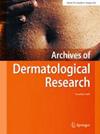Fractional CO2 laser with topical insulin versus PRP for atrophic acne scars: a randomized split-face study
Abstract
Atrophic acne scarring is a prevalent problem that has been treated with a variety of procedures, each with various degrees of success. For better results, combined regimens of treatment are recommended. Our aim was to compare the efficacy of topical insulin against topical platelet-rich plasma (PRP) as an adjunct treatment to fractional CO2 laser for atrophic acne scars. The study comprised 30 patients with atrophic acne scars. All patients underwent four sessions of fractional CO2 laser on both sides of the face at one-month intervals, followed by topical PRP treatment on one side of the face and topical insulin on the other. Two non-treating dermatologists used the Acne Scar Assessment Scale (ASAS) to assess the outcome. At their last follow-up appointment, patients were asked to assess their improvement on each side of the face in a percentage from 0 to 100%. Prior to treatment, there was no difference in the ASAS scores between the two sides of the face. One month after the last treatment session, ASAS scores improved significantly on both sides of the face. No significant difference (p = 0.794) between both sides were detected. Both techniques helped to improve atrophic acne scars and may have a synergistic outcome regarding efficacy and safety.

 求助内容:
求助内容: 应助结果提醒方式:
应助结果提醒方式:


